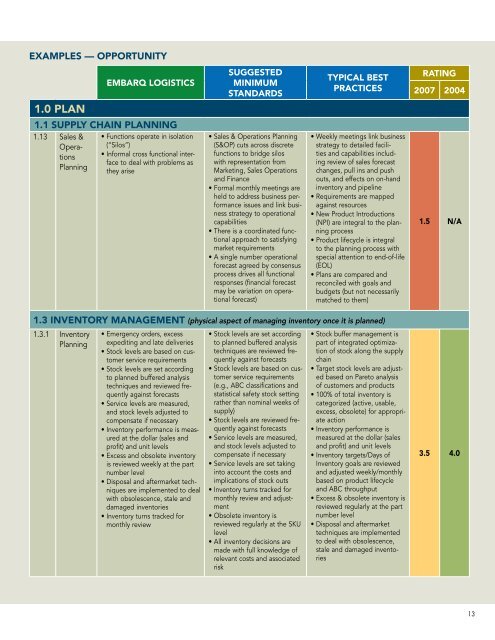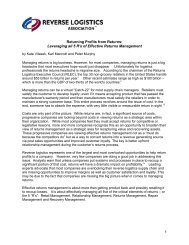PROCESS ASSESSMENT IN THE SUPPLY CHAIN: the eMBARQtM ...
PROCESS ASSESSMENT IN THE SUPPLY CHAIN: the eMBARQtM ...
PROCESS ASSESSMENT IN THE SUPPLY CHAIN: the eMBARQtM ...
Create successful ePaper yourself
Turn your PDF publications into a flip-book with our unique Google optimized e-Paper software.
exAMPleS — oPPortunity<br />
1.0 PlAn<br />
eMBArQ logiSticS<br />
1.1 SuPPly chAin PlAnning<br />
1.13 Sales &<br />
Operations<br />
Planning<br />
• Functions operate in isolation<br />
(“Silos”)<br />
• Informal cross functional interface<br />
to deal with problems as<br />
<strong>the</strong>y arise<br />
SuggeSted<br />
MiniMuM<br />
StAndArdS<br />
• Sales & Operations Planning<br />
(S&OP) cuts across discrete<br />
functions to bridge silos<br />
with representation from<br />
Marketing, Sales Operations<br />
and Finance<br />
• Formal monthly meetings are<br />
held to address business performance<br />
issues and link business<br />
strategy to operational<br />
capabilities<br />
• There is a coordinated functional<br />
approach to satisfying<br />
market requirements<br />
• A single number operational<br />
forecast agreed by consensus<br />
process drives all functional<br />
responses (financial forecast<br />
may be variation on operational<br />
forecast)<br />
tyPicAl BeSt<br />
PrActiceS<br />
• Weekly meetings link business<br />
strategy to detailed facilities<br />
and capabilities including<br />
review of sales forecast<br />
changes, pull ins and push<br />
outs, and effects on on-hand<br />
inventory and pipeline<br />
• Requirements are mapped<br />
against resources<br />
• New Product Introductions<br />
(NPI) are integral to <strong>the</strong> planning<br />
process<br />
• Product lifecycle is integral<br />
to <strong>the</strong> planning process with<br />
special attention to end-of-life<br />
(EOL)<br />
• Plans are compared and<br />
reconciled with goals and<br />
budgets (but not necessarily<br />
matched to <strong>the</strong>m)<br />
1.3 inventory MAnAgeMent (physical aspect of managing inventory once it is planned)<br />
1.3.1 Inventory<br />
Planning<br />
• Emergency orders, excess<br />
expediting and late deliveries<br />
• Stock levels are based on customer<br />
service requirements<br />
• Stock levels are set according<br />
to planned buffered analysis<br />
techniques and reviewed frequently<br />
against forecasts<br />
• Service levels are measured,<br />
and stock levels adjusted to<br />
compensate if necessary<br />
• Inventory performance is measured<br />
at <strong>the</strong> dollar (sales and<br />
profit) and unit levels<br />
• Excess and obsolete inventory<br />
is reviewed weekly at <strong>the</strong> part<br />
number level<br />
• Disposal and aftermarket techniques<br />
are implemented to deal<br />
with obsolescence, stale and<br />
damaged inventories<br />
• Inventory turns tracked for<br />
monthly review<br />
• Stock levels are set according<br />
to planned buffered analysis<br />
techniques are reviewed frequently<br />
against forecasts<br />
• Stock levels are based on customer<br />
service requirements<br />
(e.g., ABC classifications and<br />
statistical safety stock setting<br />
ra<strong>the</strong>r than nominal weeks of<br />
supply)<br />
• Stock levels are reviewed frequently<br />
against forecasts<br />
• Service levels are measured,<br />
and stock levels adjusted to<br />
compensate if necessary<br />
• Service levels are set taking<br />
into account <strong>the</strong> costs and<br />
implications of stock outs<br />
• Inventory turns tracked for<br />
monthly review and adjustment<br />
• Obsolete inventory is<br />
reviewed regularly at <strong>the</strong> SKU<br />
level<br />
• All inventory decisions are<br />
made with full knowledge of<br />
relevant costs and associated<br />
risk<br />
• Stock buffer management is<br />
part of integrated optimization<br />
of stock along <strong>the</strong> supply<br />
chain<br />
• Target stock levels are adjusted<br />
based on Pareto analysis<br />
of customers and products<br />
• 100% of total inventory is<br />
categorized (active, usable,<br />
excess, obsolete) for appropriate<br />
action<br />
• Inventory performance is<br />
measured at <strong>the</strong> dollar (sales<br />
and profit) and unit levels<br />
• Inventory targets/Days of<br />
Inventory goals are reviewed<br />
and adjusted weekly/monthly<br />
based on product lifecycle<br />
and ABC throughput<br />
• Excess & obsolete inventory is<br />
reviewed regularly at <strong>the</strong> part<br />
number level<br />
• Disposal and aftermarket<br />
techniques are implemented<br />
to deal with obsolescence,<br />
stale and damaged inventories<br />
rAting<br />
2007 2004<br />
1.5 n/A<br />
3.5 4.0<br />
13




